One of the most quoted literary passages about the great Jan van Eyck (Maaseik, c. 1390 - Bruges, 1441) is the incipit of the chapter devoted to him in Bartolomeo Facio ’s De viris illustribus (La Spezia, c. 1400 - Naples, 1457): the treatise by the Ligurian humanist, composed between 1455 and 1457, collects sixty-three lives of as many illustrious men of his contemporaries, and the peculiarity lies in the fact that in the book there are not only biographies of sovereigns or men of letters, but also of artists. Facio, driven by a strong passion for art, had been among the first Italian commentators to deal with Flemish artists, and had fully grasped the astonishing novelty of van Eyck’s art. Thus we read in the biography dedicated to the artist: “Iohannes Gallicus nostri saeculi pictorum princeps iudicatus est, litterarum nonnihil doctus, geometriae praesertim et earum artium quae ad picturae ornamentum accederent, putaturque ob eam rem multa de colorum proprietatibus invenisse, quae ab antiquis tradita ex Plinii et aliorum auctorum lectione didicerat” (“Jan van Eyck is considered the first among the painters of our century, had not a little knowledge of literature and especially of geometry and other arts that enable painting to stand out, and he is believed to have discovered many things about the properties of colors, which he had learned by studying Pliny and other authors.”). On the subject of Pliny, it has been noted that Facius himself followed the great Latin author in describing van Eyck (in fact, his words trace those that Pliny had used in the Naturalis historia to extol Panfilo of Antipolis, a great classical painter), especially where it is specified that the artist had knowledge of literature and geometry: and it is interesting to elaborate on the technical skills and theoretical knowledge that Facius attributed to van Eyck, since the Flemish artist was at the head of a revolution that would change painting, and that this revolution cannot be explained without these out-of-the-ordinary skills.
The largest exhibition ever held on van Ey ck(Van Eyck. An optical revolution, at the Museum voor Schone Kunsten in Ghent from February 1 to April 30, 2022) calls it an “optical revolution”: in the exhibition’s catalog, art historian Maximiliaan Martens (who is curator along with Till-Holger Borchert and Jan Dumolyn) explains that, by this expression, we can understand the terms in which van Eyck had altered the perception of light in ways that would continue to affect the history of painting for centuries. The point of departure is precisely Facio’s assertion that Jan van Eyck read Pliny’s text: an assertion that cannot be verified by documentary evidence, and therefore can only be scrutinized in the light of the Flemish painter’s works that we know. A starting point might be theAnnunciation painted in grisaille and now in the Thyssen-Bornemisza Museum in Madrid: in the work, the angel’s wing is placed above the frame containing it and seems almost to move in the direction of the sitter. Similar examples are found in other works by van Eyck (e.g., in the Polyptych of the Mystic Lamb: note Adam’s foot striding toward the viewer). According to Rudolf Preimesberger, a German scholar who is convinced that van Eyck had actually read Pliny and the “other authors” mentioned by Facio (he talked about this just in an essay devoted to the MadridAnnunciation ), this illusionistic detail would confirm that van Eyck had learned the ancient concept of eminentia, that is, the ability on the part of an artist to create illusions in the painting by making it seem as if the objects depicted on the support were leaving the space of the work of art and entering reality. Pliny mentioned this about Apelles, in Book XXXV of the Naturalis historia: here, we read that the Greek artist had created a portrait of “Alexander the Great holding a thunderbolt in the temple of Diana Ephesia, and it seems as if the fingers protrude and the thunderbolt comes out of the painting.” To render the verb “protrude,” Pliny had used the term eminere, and this is the same effect van Eyck had tried to achieve with the two details mentioned above. But the comparisons between van Eyck’s works and Pliny’s texts could go on: Martens, for example, suggests that, in the central compartment of the Polyptych of the Mystic Lamb, the bunches of grapes and the draperies of the figures hark back to the legendary dispute between Zeuxius and Parrasius, as part of which the two painters allegedly depicted, respectively, bunches of grapes so realistic that they fooled some of the birds that had come to peck at them, and a curtain so truthful that it led Zeusi to ask Parrasio to pull it (and the deception into which Zeusi fell convinced him to declare himself defeated, since he had succeeded in mocking animals, but Parrasio had bewildered an artist).
And again, another interesting element lies in the fact that Jan van Eyck was the first Flemish artist to date and sign his works, which could be seen as a way of wanting to assert his independence. Pliny had written that Panfilo’s merit was that he raised painting to the level of the liberal arts: again in Chapter XXXV he had in fact stated that Panfilo had received an education in all the disciplines considered noble, and especially in arithmetic and geometry, and that without this knowledge art could not have reached perfection. Consequently, at his urging, first in Sicyon (the Peloponnesian city where he worked the longest), and then throughout Greece, freeborn youth would also study painting, and therefore painting would be considered on a par with the liberal arts. Van Eyck, the first in Flanders to want to pass on his name, probably aimed to consider himself on a par with a scholar. Perhaps precisely after reading Pliny.
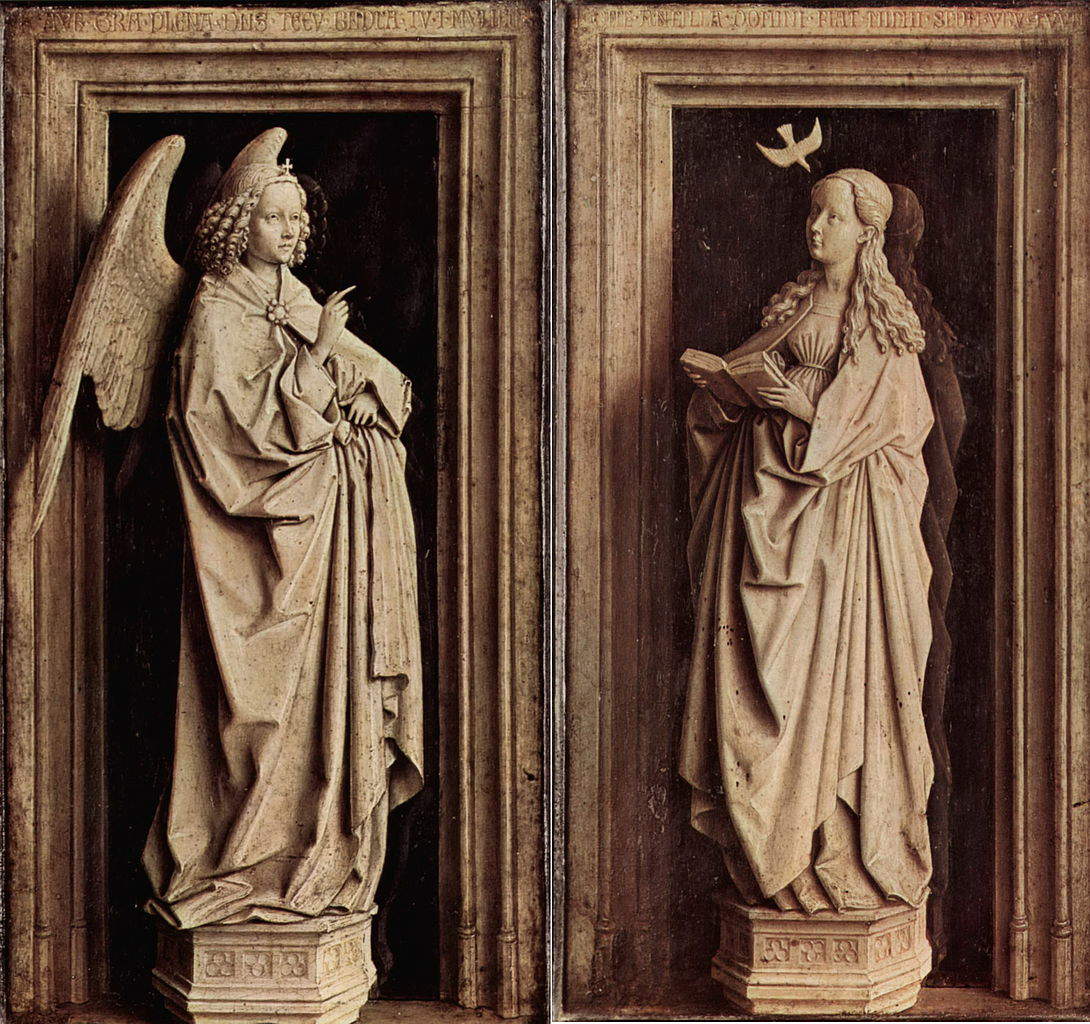 |
| Jan van Eyck, Annunciation (1440; oil on panel, 39 x 24 cm; Madrid, Museo Thyssen-Bornemisza) |
 |
| Jan van Eyck, Annunciation, detail of the angel’s wing |
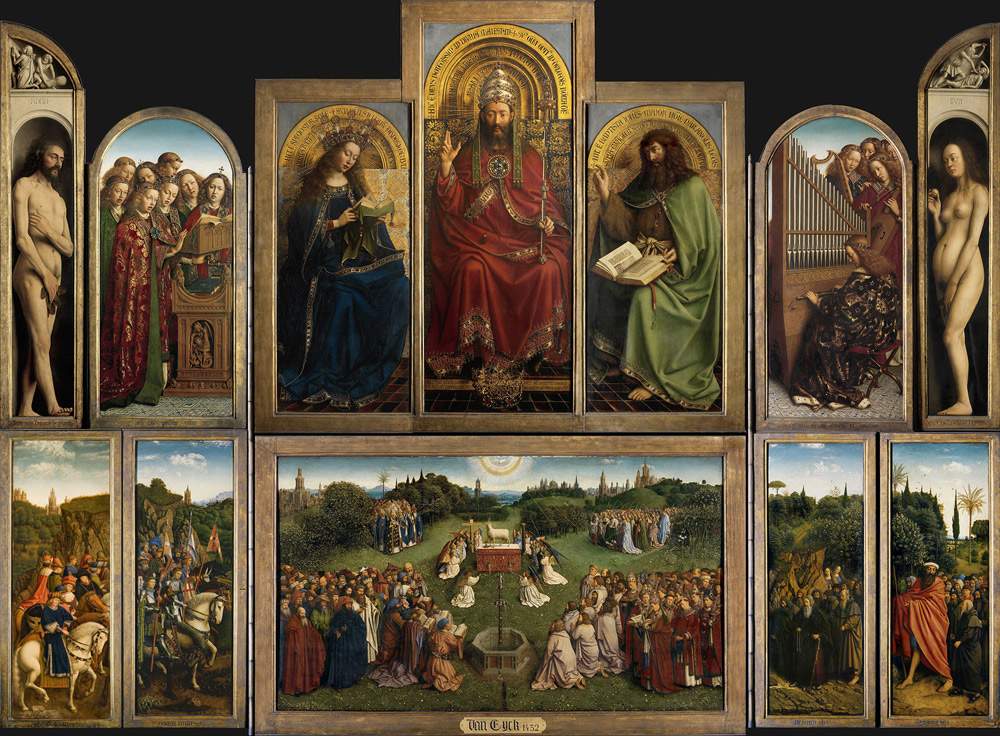 |
| Jan van Eyck and Hubert van Eyck, Polyptych of the Mystic Lamb (dated 1432; oil on panel, 350 x 470 cm open, 350 x 223 cm closed; Ghent, Cathedral of St. Bavon). Ph. Credit KIK-IRPA |
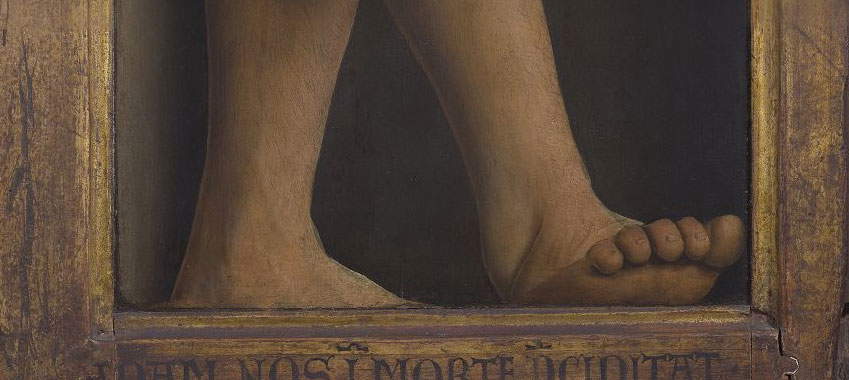 |
| Jan van Eyck and Hubert van Eyck, Polyptych of the Mystic Lamb, detail of Adam’s feet |
 |
| Jan van Eyck and Hubert van Eyck, Polyptych of the Mystical Lamb, detail of the grapes in the central panel |
Of course, perhaps these are just coincidences or somewhat forced readings: nevertheless, whether van Eyck had read Pliny or not, his technical skills represented, for his time, an extraordinary novelty, and laid the groundwork for the “optical revolution” attributed to him. The geometry of which Facio spoke did indeed take on a central role: obviously van Eyck was unaware of the canons of scientific perspective that were being worked out at that time in Florence and that would first be intuited by Filippo Brunelleschi (Florence, 1377 - 1446) and then put down on paper only in 1435 by Leon Battista Alberti (Genoa, 1404 - Rome, 1472) in his De pictura, published in Latin when van Eyck was by then at the end of his career. Nonetheless, from his paintings (the Portrait of Mr. and Mrs. Arnolfini is a prime example), one can understand how van Eyck had come to elaborate interiors scaled in depth: that he got there by empirical means, simply by observing the space around him, seems hard to believe, and it is rather more likely that he had knowledge of geometry, a subject that was studied in medieval “schools.” Martens, in particular, revealed similarities between certain elements found in van Eyck’s works and the theoretical utterances of the Arab mathematician and scientist Alhazen (Ab? Al? al-Hasan ibn al-Hasan ibn al-Haytham; Basra, c. 965 - Cairo, 1039), who helped bring to the West much knowledge about optics, on which medieval European treatises would be based. Indeed, some argue that Alhazen was also behind Brunelleschi and Alberti’s development of scientific perspective: in a 2010 essay, art historian Hans Belting wrote that the term “perspective” itself derives from the title of the Latin translation of Alhazen’s Book on Optics(Perspectiva), and that Brunelleschi and Alberti would have been silent about their source for ideological reasons ("their goal, in line with Renaissance revival ideology,“ Belting wrote, ”was to erase the Arabs’ contribution or marginalize it in favor of Euclidean geometry, even though Alhazen had gone beyond Greek antecedents in his experiments and discoveries: this explains why Alhazen today is highly regarded in the history of science but not in the history of culture or the history of art.").
Reflections of Alhazen’s theories, in van Eyck, would be found in the Portrait of Mr. and Mrs. Arnolfini. The Arab scientist had written that, given a convex mirror, the greater the distance between the object and the reflecting surface, the lower the degree of reflection, and the wider the radius of curvature of the mirror, the greater the distortion. Van Eyck would seem to apply this principle in the mirror in the center of the Portrait of Mr. and Mrs. Arnolfini: in the image we see the bride and groom in the center, two other figures farther away and smaller (one of them perhaps being the painter himself), and most importantly we notice how the window undergoes a strong distortion. The same is also true for the refraction of light rays, and Martens suggests the example of the Virgin and Child and Canon Joris van der Paele, where St. George’s helmet, made of many convex elements joined together, reflects light realistically (i.e., with more concentration in the center, and more thinning instead as the surface curves) suggesting the curvature of the metal: and the behavior of light on a convex reflective surface had also been described by Alhazen. Similar ways of dealing with light on armor are also found in the Milites Christi that appear in the Polyptych of the Mystic Lamb, exceptional also because, in the same figures, we see how van Eyck also deals with light on a concave surface, that of the shields of the two figures on horseback (and similar refractions are what we can appreciate in the basin of theAnnunciation on the closed compartments of the Polyptych of the Mystic Lamb). And again, optical effects of great intensity are those that, again in the Polyptych of the Mystic Lamb, we notice in the figure of the All-Father: the material of which the pearls that adorn his robe, and in particular the sash on his chest (where the pearls create the inscription “Sabaot”) are made, Martens writes, “partially diffuses, absorbs and reflects the reflected light, creating a soft secondary refraction behind them, and at the same time forming a shadow behind the pearls, on the fabric of the cloak.” Similar refractive effects affect the glass scepter held by God the Father.
One might ask what degree of knowledge van Eyck had about optics: Martens responds by stating that notions of optics were widely spread among the educated classes of the time, and it was knowledge that also filtered through literature, as well as through scientific treatises. “Since van Eyck frequented the court and other elite circles,” Martens argues, “he probably must have had knowledge on the subject, and likewise we can assume that he was familiar with some classical authors, although he received no formal academic instruction. We can also imagine him discussing the optical qualities of materials with fellow goldsmiths like Jan de Leeuw or Jean Peutin.” And if, as Facio argues, van Eyck was an expert in geometry (to the point that the humanist from La Spezia thought he should emphasize this knowledge), “then,” Martens concludes, “there should be no doubt that van Eyck knew at least the basic principles of optics.” Moreover, it should be added that we know for a fact that Alhazen’s Book of Optics had been circulating in Flanders for some time: we do not know whether van Eyck had occasion to consult a copy, but it should not have been so difficult to access its contents.
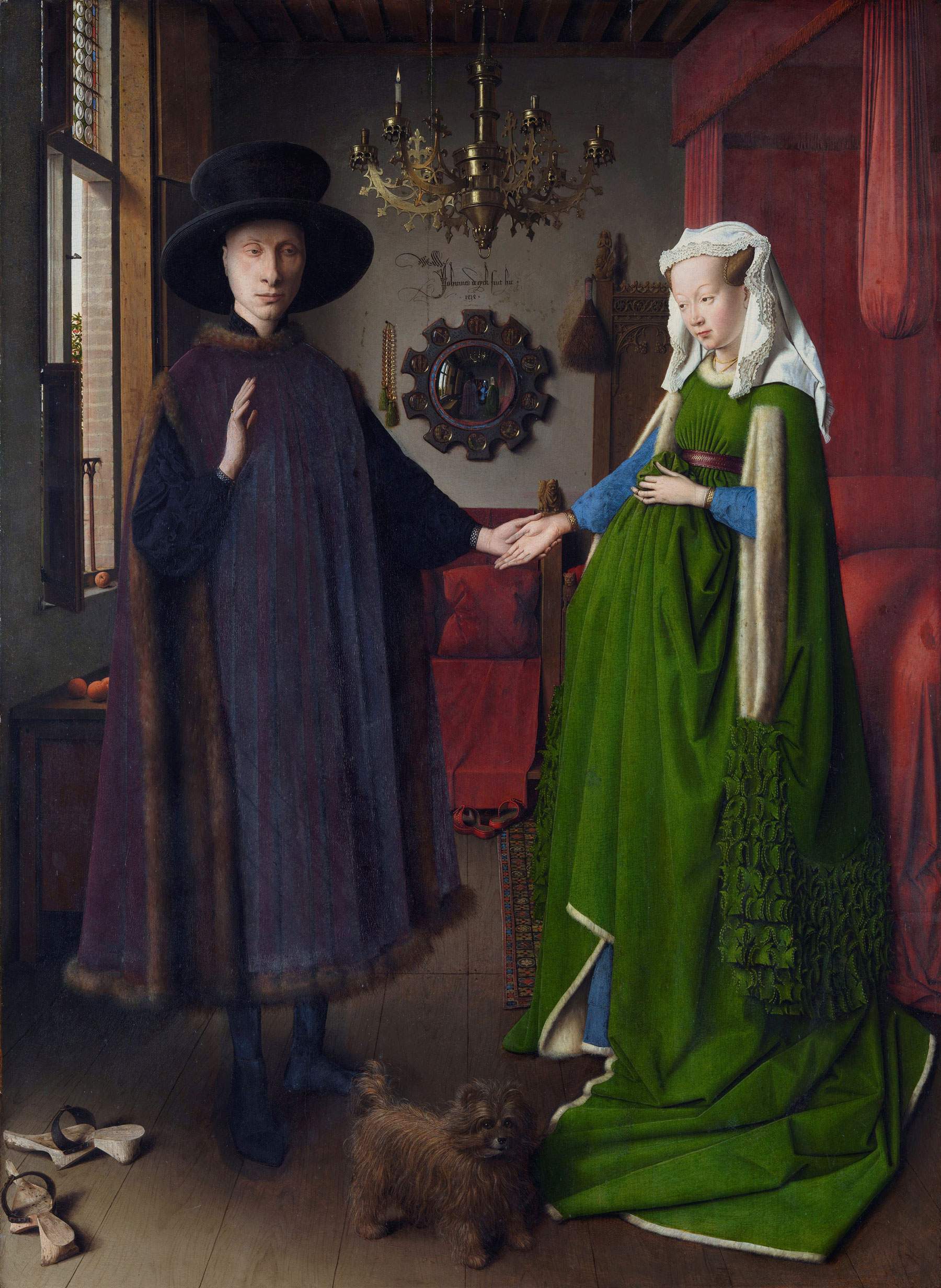 |
| Jan van Eyck, Portrait of Mr. and Mrs. Arnolfini (1434; oil on panel, 818.8 x 59.7 cm; London, National Gallery) |
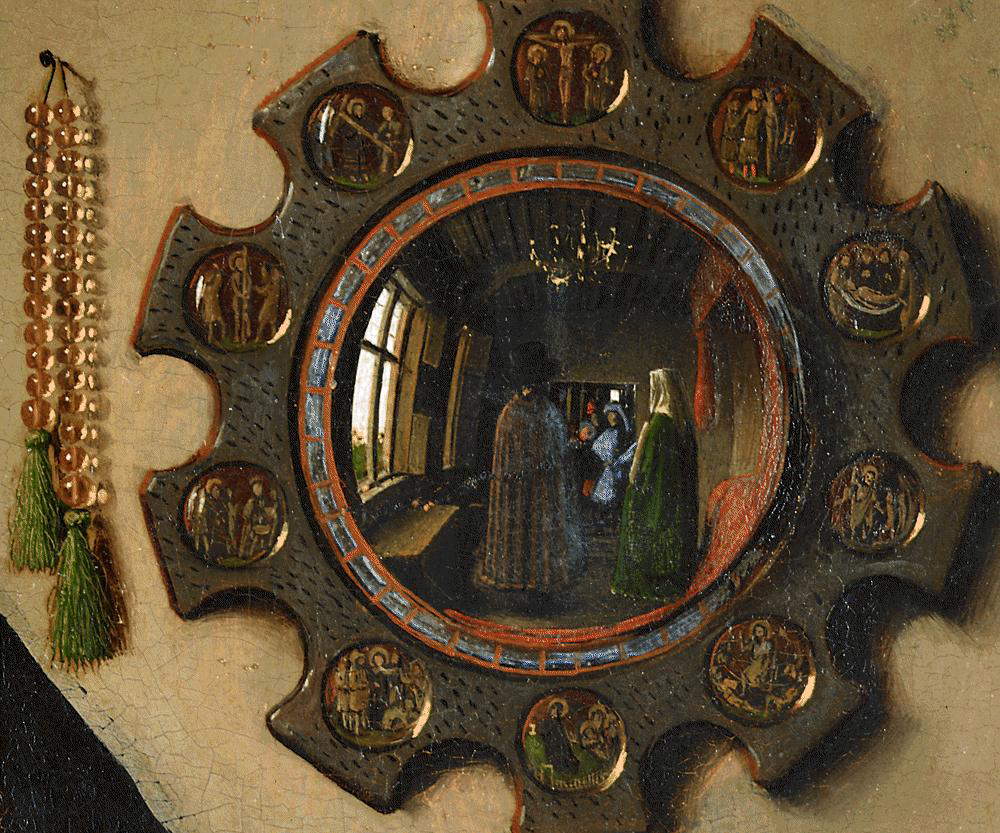 |
| Jan van Eyck, Portrait of Mr. and Mrs. Arnolfini, detail of the mirror |
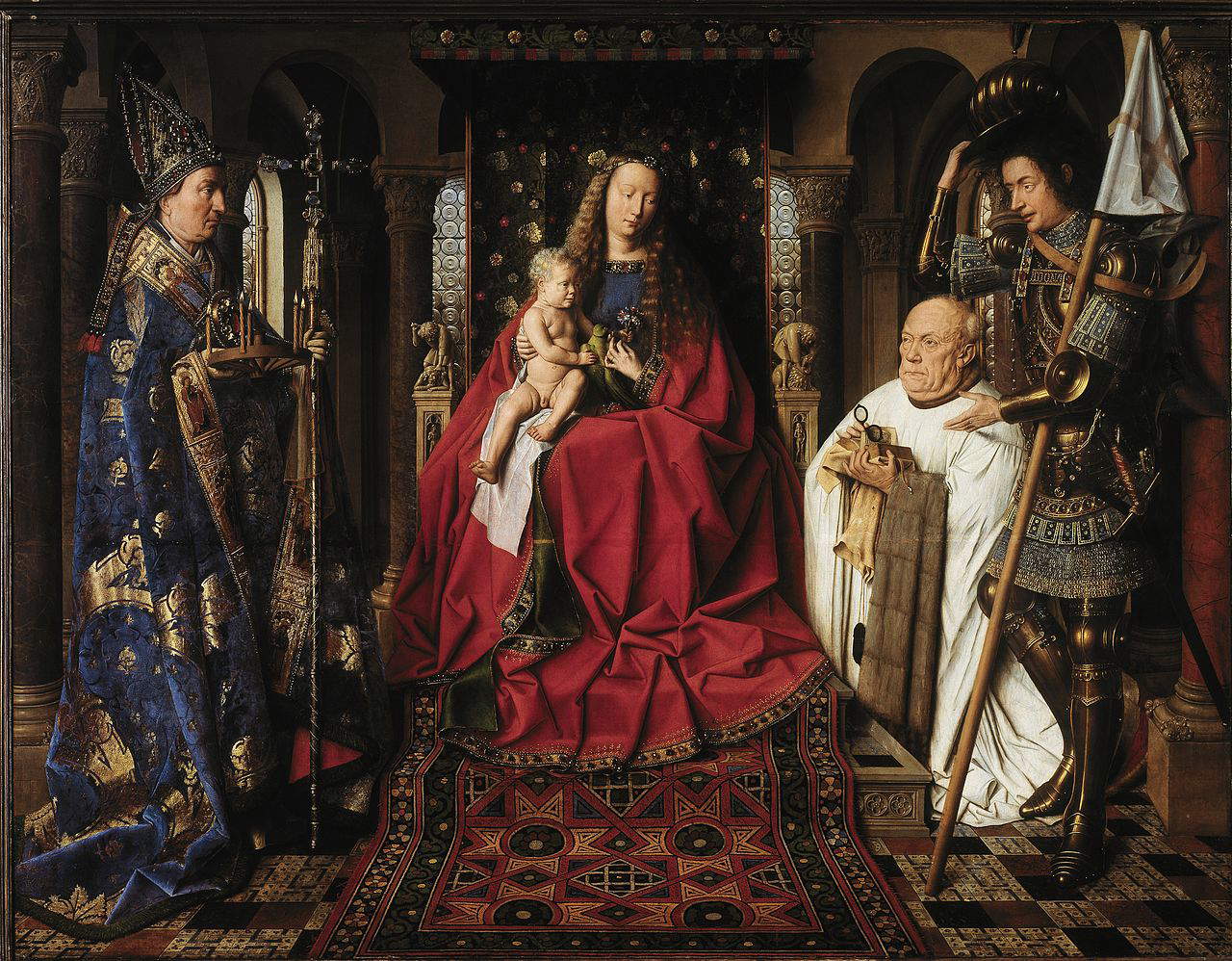 |
| Jan van Eyck, Madonna of Canon van der Paele (1436; oil on panel, 122.1 x 157.8 cm; Bruges, Groeningemuseum) |
 |
| Jan van Eyck, Madonna of the Canon van der Paele, detail of the helmet of St. George |
 |
| Jan van Eyck and Hubert van Eyck, Polyptych of the Mystical Lamb, detail of the Milites Christi |
 |
| Jan van Eyck and Hubert van Eyck, Polyptych of the Mystical Lamb, detail of the Milites Christi |
 |
| Jan van Eyck and Hubert van Eyck, Polittico dellAgnello Mistico, the Deësis with, in the center, the Padreterno |
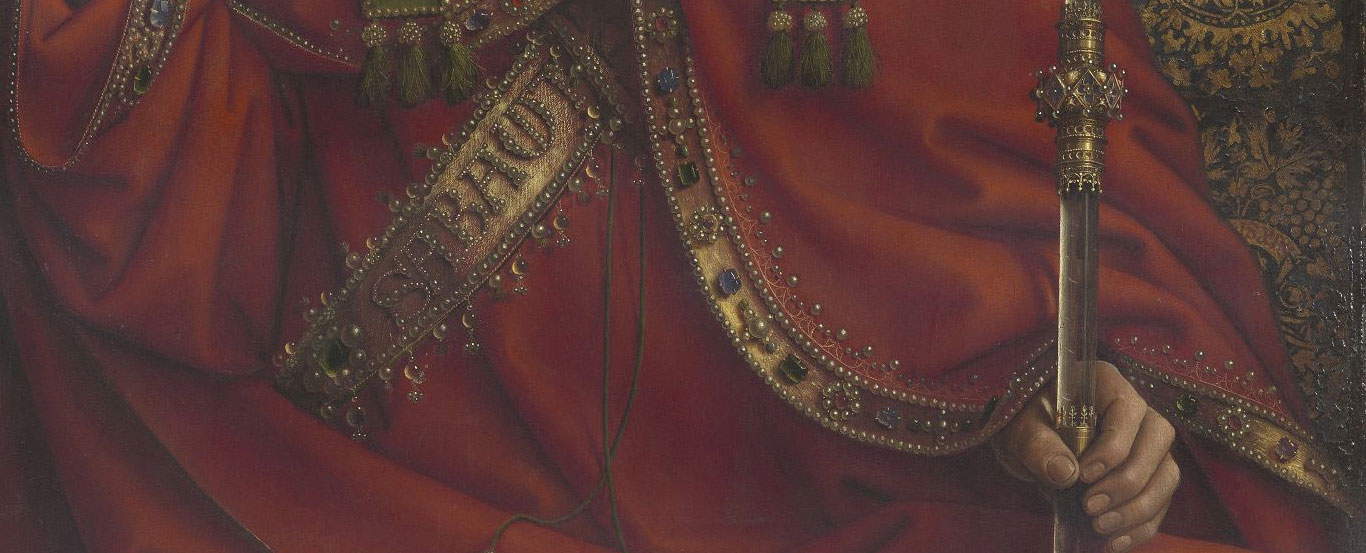 |
| Jan van Eyck and Hubert van Eyck, Polyptych of the Mystical Lamb, detail of the figure of the All-Father |
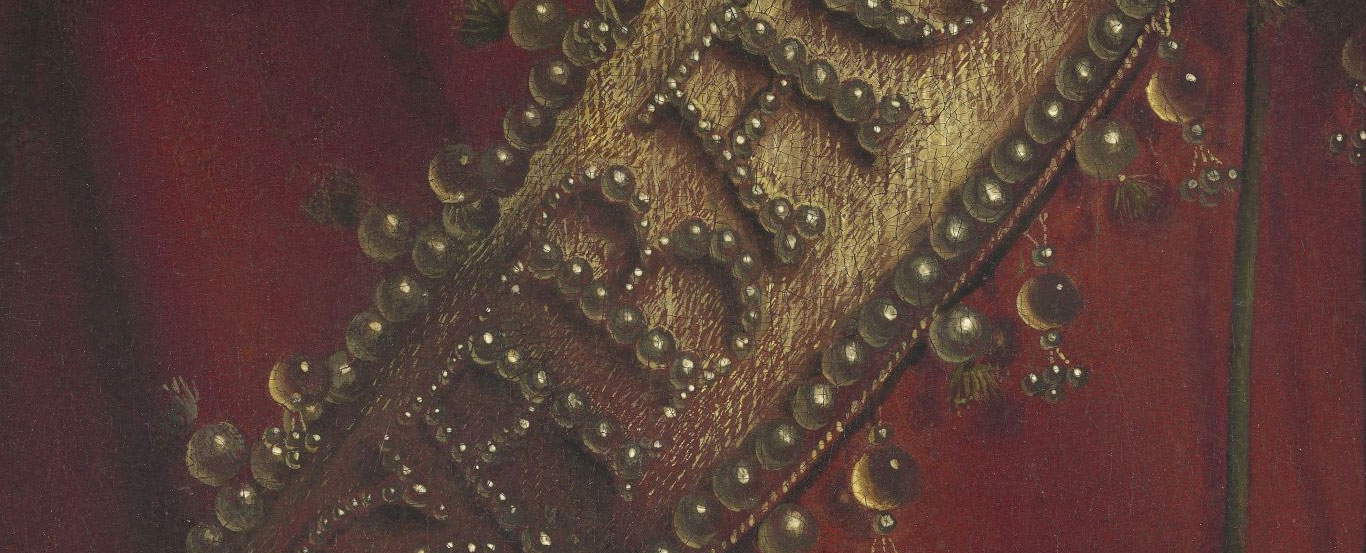 |
| Jan van Eyck and Hubert van Eyck, Polyptych of the Mystical Lamb, detail of the figure of the All-Father |
Then there is another point on which Facio insists, namely, that van Eyck “discovered many things about the properties of colors” (a focus that will come as no surprise, if one remembers, as Michael Baxandall has pointed out, that “Facio’s insistence on van Eyck’s research on colors is the first attestation of a recurring theme in fifteenth- and sixteenth-century critics”). Actually, on this point the question is more arduous. It has been suggested that Facio might allude to the traditional attribution of van Dyck’s invention of oil painting, although here we move more into the realm of legend than history: already Philarete, in his Treatise on Architecture composed between 1460 and 1464, had written that there were many northern artists skilled in oil painting (“in the Magna they work well in this form”), and Jan van Eyck was not credited with any special merits, especially since he is mentioned together with Rogier van der Weyden and placed on the same level as his colleague. Having discarded this hypothesis, one might think of pigments, but van Eyck was not distinguished by any particular innovations, as he used materials that painters had already had for some time. At present, therefore, we cannot determine what Facio meant by his phrase.
Finally, a further point to emphasize if we talk about van Eyck’s “optical revolution” is the illumination the painter needed to put his knowledge into practice. A point dwelt on precisely at the Gent exhibition: “as is well known,” Martens writes, "the lighting in the Polyptych of the Mystic Lamb corresponds with the natural lighting coming from the southern windows of the Vijd chapel [Joos Viijd was the commissioner of the polyptych, nda]. In the altarpiece, the light comes from the upper right corner, the same direction as the sun’s rays in the chapel on a sunny afternoon in late spring or early summer. An exceptionally high degree of consistency can be seen there." A consistency in the lighting scheme that invests every minute detail of the entire complex machine created for St. Bavon’s Cathedral. The only two exceptions are the city view (where the lighting comes from the left) and theAnnunciation, where the light radiates above the figure of Mary through the window that is placed behind her (this is, therefore,symbolic lighting). Otherwise, all the figures, including the difficult scenes in the central panel, are illuminated with a degree of uniformity that had hitherto been unprecedented (and the same is true of all the individual details: jewelry, robes, hair styles), and this necessarily leads to a question: how had van Eyck managed it? Had he been able to create for himself a constant source of illumination? Or had he successfully recreated, in his studio, the lighting conditions of the Vijd chapel? Or is the polyptych just a combination of a vast number of preparatory studies, even though there is no trace of them left? The point is that van Eyck should have procured conditions such that he was able to paint not only the light in the same direction, but also with the same intensity throughout the painting. However, this is only true if one admits that Jan van Eyck worked based solely on direct observation. For Martens, the possible explanation for such extreme consistency on such a large and complicated work lies in the fact that “van Eyck relied not only on the power of his observation, but also on his knowledge.” It is therefore likely that van Eyck had studied the way the light in the chapel reflected off the surfaces and then elaborated on what he had studied on the spot: to do this, says Martens, “it was enough to be familiar with the principles of incidence of light, shadow formation, the creation of refractions, inversions and deformations, and phenomena such as focal point and focal length: in short, ’quae ad picturae ornamentum accederent’.”
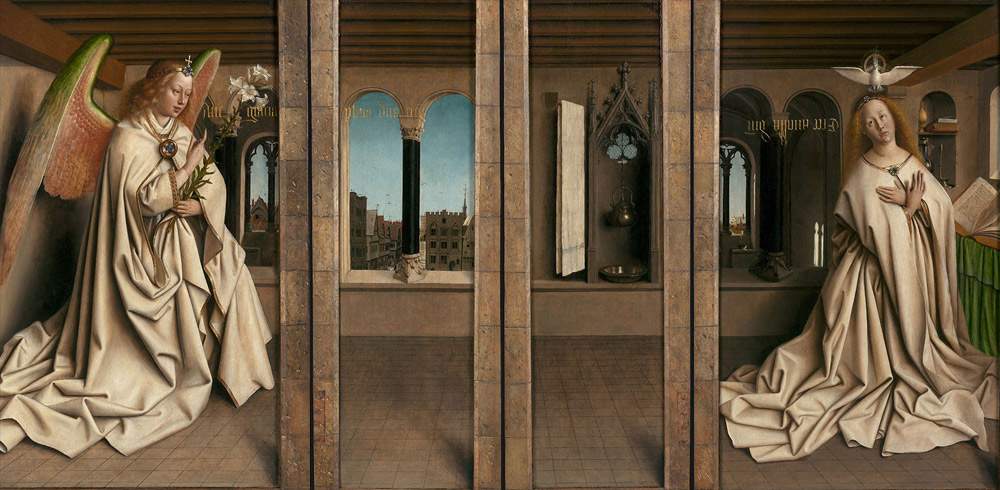 |
| Jan van Eyck and Hubert van Eyck, Polyptych of the Mystical Lamb, the Annunciation |
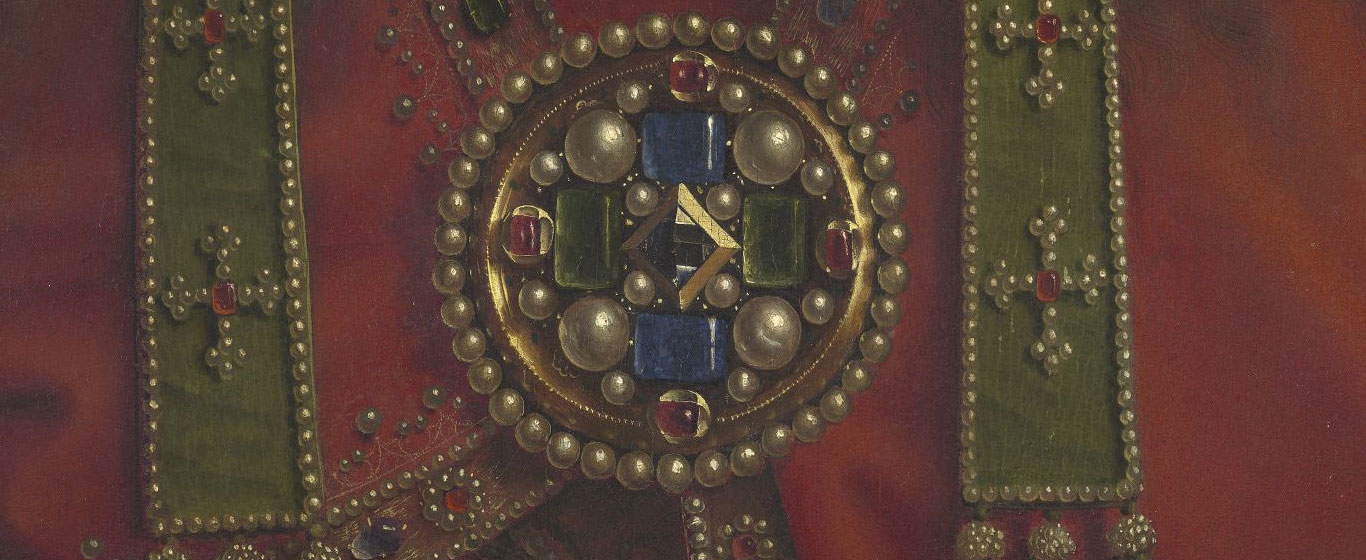 |
| Jan van Eyck and Hubert van Eyck, Polittico dellAgnello Mistico, detail of the figure of the Padreterno |
In conclusion, van Eyck’s masterpieces and his “optical revolution” can be explained on the basis of a great mastery of technical skills and a certain amount of scientific knowledge that the artist had gained in his Flanders: knowledge that he was evidently able to rework to bring his painting to a level of realism that no one had ever seen before. Indeed, we know very little about his life: we have no idea of the studies he undertook, nor do we know for sure where the stimulus came from for him to create works aimed not only at imitating reality as closely as possible, but at creating unprecedented illusionistic effects. That the artist was so fond of classical literature that he exalted himself by reading about the achievements of the painters of ancient Greece with the help of Pliny or other authors, is possible, but seems unlikely and very much out of keeping with the spirit of the times. More likely, if anything, is that it was the cultural milieu in which van Eyck lived and worked that had the greatest influence on his painting: it will therefore be interesting to recall that, for almost half of his career, van Eyck was court painter to Duke Philip III of Burgundy, for whom, moreover, he also held diplomatic posts (a sign that Jan van Eyck was a person of high intellectual caliber). It was most likely through his frequentations at the court of Philip of Burgundy that the painter began to measure himself against ancient art (albeit ... on paper) and, above all, with a desire to innovate.
Of course, van Eyck’s art should not be considered only on the level of his undeniable formal achievements. His works must also be read as important documents relating to his time, and often the content of the works also dictated stylistic and formal choices (this was seen, just by way of example, with theAnnunciation of the Polyptych of the Mystic Lamb). But if we consider that, as Federico Zeri remarked, “light was to the Flemings of the fifteenth century what three-dimensional perspective was to the Italians in the same era,” it is precisely because of his innovations that Jan van Eyck is to be considered one of the greatest artists of his time, and as such he was already considered by his contemporaries, who immediately grasped the importance and originality of his research.
Essential Bibliography
The author of this article: Federico Giannini e Ilaria Baratta
Gli articoli firmati Finestre sull'Arte sono scritti a quattro mani da Federico Giannini e Ilaria Baratta. Insieme abbiamo fondato Finestre sull'Arte nel 2009. Clicca qui per scoprire chi siamoWarning: the translation into English of the original Italian article was created using automatic tools. We undertake to review all articles, but we do not guarantee the total absence of inaccuracies in the translation due to the program. You can find the original by clicking on the ITA button. If you find any mistake,please contact us.